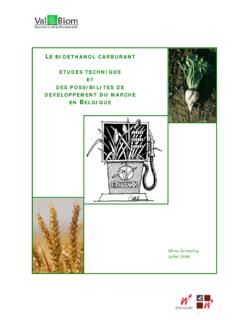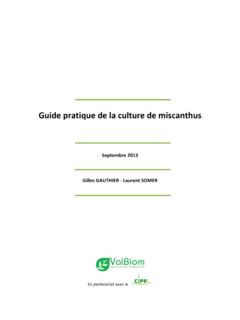Transcription of 1. BIOGAS PRODUCTION IN THE WALLOON …
1 1 1. BIOGAS PRODUCTION IN THE WALLOON REGION (BELGIUM) anaerobic digestion of cattle effluents (2006 data) Part of the research in the field of biomethanation in Benelux is dedicated to development of BIOGAS technology in the agricultural sector. Because of recent Common Agricultural Policy reforms orientated to Rural development and also in the view of the entry of new member states to the European Union where cereals and oilseeds PRODUCTION is important and agricultural sector is highly competitive, agricultural sector in Western Europe needs to diversify productions and to find other income sources.
2 Energy crops now allowed to be grown on set-aside lands can make substantial capital gain. Needs for redeployment encourage farmers to move over PRODUCTION and supply of renewable energy through anaerobic digestion of agricultural products. Research also focuses on other concerns as sanitary problematic, odour control of biowaste or pathogen reduction in organic In Flanders special attention is paid to manure management and treatment. With intensive husbandry in the Northern part of Benelux, the Flemish has to tackle with the management of huge amount of manure produced each year.
3 As AD of biomass is a way for green energy PRODUCTION , the fate of AD-sludge remains an essential issue as the volume of the digestate must be treated and reduced in order to spread or export it more easily. Several research projects are studying technical and economical feasibility of AD sludge treatment. In Wallonia there are 4 agricultural BIOGAS plants (decentralised farm plants). 2 farms are in the eastern part of Belgian near the German border. One farm uses mainly pig manure with grass and a few residues from a local chocolate factory. The second treats cattle effluents (cow manure) mixed with grass and little amount of waste from food-industry.
4 The third one uses cow manure with energy crops (ma ze) and by-products from a chocolate factory. The last one, operating since June 2006, uses a mix of pig and cow manure with energy crops (grass silage + ma ze). There is also a pilote-unit in an agricultural research centre using cow manure in 3 little digesters (10m capacity). BIOGAS produced is used as fuel in a BIOGAS boiler that provides heat to greenhouses. Table 1 : Characteristics of agricultural BIOGAS facilities in Wallonia (Source: Centre wallon de Recherches Agronomiques CRA-W, 2006) BIOGAS plant Co-substrate (ton/y) Digester volume (m ) BIOGAS PRODUCTION (m /y) Electric capacity (kW el.)
5 Electricity PRODUCTION (kWh el. /y) Heat PRODUCTION (kWh th. /y) Wallonia 1. Ferme Kessler (Town: Attert) Since 2003 Cattle manure: solid: 2650 slurry: 2250 Energy crops:maize + grass: 1150 Food industry wastes (fruits, chocolate, potatoes): 7000 2 x 750 1 330 000 390 2 260 000 3 100 000 22. Suz nergie (Surice) Since June 2006 Cattle manure: solid: 2400 slurry: 500 Energy crops (maize + grass): 800 1 500 300 000 104 530 000 750 000 3. Ferme Lenges (Recht) Since 1999 Cattle manure: Slurry: 4 700 m Solid: 650 t Energy crops: grass: 350 Food industry wastes: chocolate 250, vegetables: 120 Sludge: 1000 600 + 1800 950 000 360 1 700 000 8 500 000 Ferme Heck (Nidrum) Since 2001 Cattle manure: Slurry: 2000 m Solid: 1400 Energy crops: Grass: 750 Food industry wastes: 700 1 800 360 000 100 605 000 1 200 000 For farms 1 & 2: Consultancy and installation: LEE sarl Zone artisanale Langwies BP 7 L-6101 Junglinster (Luxembourg) Tel : +352 78 82 72-800 Fax : +352 78 82 72 448 Contact: Jean Schummer For farms 3 & 4.
6 Consultancy and installation: Welter sarl La Maison, 168 L-9940 Asselborn (Luxembourg) Tel :+352 997 021 Contact : Romain Welter Currently there are several BIOGAS projects in the agricultural sector. Several cooperatives of farmers have initiated feasibility studies. Most of the projects are involving a few farms and planned to used manure as main substrate with a mix of energy crops (grass + corn). They also try to find local food-industries willing to treat their by-products by AD. However, partnerships between industrial and agricultural sectors need to develop in order to maximize efficiency of BIOGAS PRODUCTION and rise profitability of the sector.
7 anaerobic digestion of industrial waste or by-products (2004 data) Some industries, especially food-industries, has chosen biomethanation to treat a part of their effluents or by-products. Most of them are sugar beet industries (sugar beet grating or sugar refinery). Table 2: Energy PRODUCTION from anaerobic digestion of sugar industry in Wallonia, (Source: ICEDD, 2004) BIOGAS PRODUCTION Primary PRODUCTION Crude Electricity Net Electricity Steam produced on-site 1 912 000 m 14 926 MWh 809 MWh el 770 MWh el 5 234 MWh There is also a jam factory equipped with 2 digesters (200m each) using fluidized beds with biolite producing 1000m of BIOGAS per day.
8 3 Since 1986 a industry processing potatoes (Van den Broeke-Lutosa) treats its effluents by anaerobic digestion. End of November 2002 this industry in partnership with an electricity provider has inaugurated the biggest CHP installation in Belgium. The plant is equipped with 2 engines with a total power of MWel. providing heat (2 MWth power ) and steam at a rate of 2 t/hour. Table 3: Energy PRODUCTION from anaerobic digestion of industrial waste (sugar industry not included) in Wallonia, (Source: ICEDD, 2004) BIOGAS PRODUCTION Primary PRODUCTION Crude Electricity Net Electricity Steam produced on-site 1 611 000 m 10 311 MWh 3 816 MWh el 3 656 MWh el 4 507 MWh anaerobic digestion of municipal household wastes In Belgium, BIOGAS results mainly from landfills but also from anaerobic treatment of urban and industrial waste.
9 Several waste treatment units in Belgium use the Belgian DRANCO process to treat organic waste from households, (food-) industries or catering. DRANCO (Dry anaerobic Composting) system was developed by OWS firm to digest organic waste with high dry matter content. The anaerobic digestion is followed by an aerobic composting step. The final products are BIOGAS that can be energetically converted, and compost called Humotex. In 2000, a BIOGAS plant treating municipal household organic waste was inaugurated in Havr , near the town of Mons. This plant is run by a intermunicipal operator.
10 The installation is planned to treat 54 000 tonnes of household waste injected into 2 digesters (3 800m each) with a retention time of 3 weeks. The plant is equipped with 4 engines of a power of 459 KWel each and 4 boilers of a thermic power of 1 350 KWth each. At the beginning the BIOGAS plant was not functioning at full capacity and BIOGAS PRODUCTION was not significant. In 2004 millions Nm of BIOGAS were used to produce 4 448 MWh electricity and heat that was used to heat organic waste before the AD process. Table 4: Energy PRODUCTION from anaerobic digestion of household organic waste in Wallonia, site of Havr.





